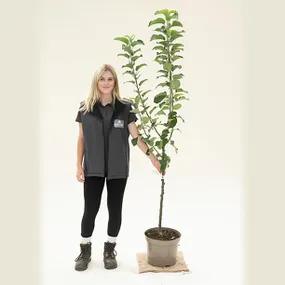Annie Elizabeth Apple Trees

The details
- Cooking: Keeps shape after cooking.
- Spur bearer (Good for cordons & espaliers)
- Partially self fertile
- Pollinator
- Pollination Group E
- Crops in October. Stores till April.
Recommended extras
Description
Annie Elizabeth Cooking Apple Trees
Annie Elizabeth apples are mid-season cookers that store well. The apples are large but firm enough so that when they soften as they are cooked (baked or stewed) they hold their shape. The skin is tough and waxy both of which are qualities needed by apples you want to store and Annie Elizabeth will keep for up to 6 months in a cool, dry, frost-free place. This is a fast-growing, hardy tree and its blossom is a sumptuous, deep pink-red.
Browse our full range of apple trees for sale or see the full variety of fruit trees available online.
Characteristics:
- Use: Cooking. Sweet & mild flavour, keeps its shape.
- Spur Bearer: suitable for cordons & training on wires.
- Tree's growth habit: Strong vigour. Upright, compact form.
- Harvest: Early-mid October.
- Store & ripen in a cool, dry place: Until April
Pollination Partners for Annie Elizabeth:
Your trees are partially self fertile and their flowers must be pollinated to make good crops.
Annie Elizabeth is in pollination Group E.
This means that they will cross-pollinate with other apple trees in pollination Groups D, E and F.
This tree's flowers have good frost resistance.
See our Guide to Apple Tree Pollination for a full list of partners & more tips about pollination.
Disease resistance: Scab, Canker
History & Parentage:
Mr Samuel Greatorex raised this tree around 1857, possibly from the pip of a Blenheim Orange apple. It was propagated and sold by Harrison's of Leicester about 10 years later. It was a commercially grown tree for some decades in the UK, disappearing from farms during the 20th century's decline in orchards.
How Apple Trees are Measured & Delivered:
Our fruit trees are delivered in 3 shapes and you can also buy selected apple trees as ready made cordons.
Maiden: This unbranched tree is the smallest starting size. You can train maidens into espaliers and cordons.
Cordon: Annie Elizabeth trees are spur-bearers, so they can be made into cordons and espaliers.
Bush: This is a style of freestanding tree with a short trunk of about 60cm. It will grow to about 3 metres tall.
Half-Standard: This is a freestanding style that will grow into a full sized, "normal" apple tree, about 4 metres tall.
Planting Instructions
Notes on planting Annie Elizabeth trees:
All fruit trees like a rich soil with decent drainage, protection from the wind and plenty of sun. Apple trees like clay soil, as long as it is not prone to bad waterlogging.
This tree is suitable for organic growing in the more humid West and South of Britain, where scab and canker are more common. It is also recommended for the North & Scotland because of its late opening, frost resistant flowers.
Prepare your site before planting:
Improving the soil in advance of planting your apple trees will help them establish quickly and be productive for years to come. After you have destroyed all the weeds and grass (use Neudorff WeedFree Plus weed-killer for tough weeds), you can dig the soil over. Remove any stones and rubbish and mix in well rotted compost or manure down to the depth of about 2 spades. You can do this on planting day, but when you do it weeks or months in advance, you will give the soil time to settle again.
Spacing Annie Elizabeth apple trees:
Freestanding bushes: 12-18 feet (4-6 metres) between trees and rows.
Freestanding half-standards: 18-30 feet (6-10 metres) between trees and rows.
In general, allow 1 more metre between rows than there is between each tree in the row.
Wire-trained cordons can be planted in rows 60-100cms apart.
Espaliers need to be spaced at 10-18 feet (3-6 metres) apart.
Watch our video on how to plant a fruit tree for full instructions on planting a bush or half-standard sized tree.
If you are growing a maiden sized apple tree into a freestanding tree, a bamboo cane is enough support.
If you are growing a cordon or espalier, you will need to install training wires to support them.
Remember to water establishing apple trees during dry weather for at least a year after planting.
Apple Tree Planting Accessories:
For bush and half standard apple trees, our tree planting pack includes a wooden stake & rubber tie to support the tree and a biodegradable mulch mat with pegs, which protects the soil at the base of your tree from drying out and stops weeds from sprouting.
We recommend using mycorrhizal "friendly fungi" on the roots of all new trees, especially if your soil is poorly fertile.

 Annie Elizabeth Img 1.webp)
 Annie Elizabeth Img 1.webp)

 Annie Elizabeth Img 2.webp)